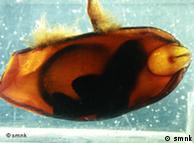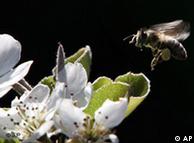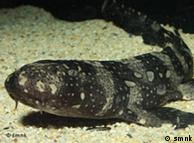The whitespotted bamboo shark, nicknamed Little Mary, was given
to the Natural History Museum in the southwestern German city of
Karlsruhe as a gift more than a decade ago. Since then she has become a
bit of a sensation in scientific circles.
In 2001, the small, black and brown shark began laying eggs. This in
itself is no great feat in nature; many animals, including reptiles,
birds and other sharks will lay unfertilized eggs. Johann Kirchhauser,
biologist in charge of the museum's aquariums, along with the rest of
his colleagues assumed the eggs would remain unfertilized, since there
was no male shark in the tank.
But Little Mary proved them all wrong. Despite her lack of a partner,
several of the 20 eggs she laid developed into embryos. Ultimately,
four tiny sharks successfully developed and hatched from those eggs.
 Bildunterschrift:
Großansicht des Bildes
mit der Bildunterschrift: Of
the original 20 eggs, four developed into embryos
Bildunterschrift:
Großansicht des Bildes
mit der Bildunterschrift: Of
the original 20 eggs, four developed into embryos
Kirchhauser sought an explanation for the miraculous births. A
specialist told him that some sharks have the ability to store sperm in a
special organ, known as a shell gland, to use later. Cat sharks, for
instance, have been known to do it for up to two years.
The bamboo shark had been living at the Karlsruhe aquarium for five
years. "It seems that makes her a world champion in terms of sperm
storage," Kirchhauser told Deutsche Welle.
Unexpected development
Much to the museum's amazement, the bamboo shark continued to produce
offspring - in 2002, 2003, and 2004. Then, suddenly, the eggs stopped
developing into embryos.
 Bildunterschrift: Großansicht des Bildes
mit der Bildunterschrift: Many
insects, including certain honeybees, can reporduce via parthenogenesis
Bildunterschrift: Großansicht des Bildes
mit der Bildunterschrift: Many
insects, including certain honeybees, can reporduce via parthenogenesis
The biologists assumed the sperm supposedly stored in the shark's
shell gland had dried up but Little Mary continued to prove she still
had a few surprises left in her. In 2009, she managed to produce one
viable egg.
Kirchhauser and his colleagues were stunned. If Little Mary were, in
fact, using stored sperm, it meant that she had managed to keep it
usable for over 13 years, something completely unheard of.
Reproductive anomaly
Things began to make a little more sense after the team learned some
new information about shark reproduction which was recently unearthed.
In 2008, scientists in the United States documented the case of a
hammerhead shark that had reproduced without the use of sperm. This form
of asexual reproduction is called parthenogenesis, and while insects
and other less developed life forms often use the technique, it's
extremely rare in vertebrates.
Suspecting this might be the key to the mystery, the biologists in
Karlsruhe took some DNA samples from Little Mary and several of her
offspring. Their DNA proved to be identical, showing that
parthenogenesis had indeed taken place.
Miracle offspring
 Bildunterschrift:
Großansicht des Bildes
mit der Bildunterschrift: The
baby sharks only carry their mother's DNA. No male DNA is present
Bildunterschrift:
Großansicht des Bildes
mit der Bildunterschrift: The
baby sharks only carry their mother's DNA. No male DNA is present
It's the first documented case of asexual reproduction in sharks in
Europe and it has stunned the scientific community. And the story now
has yet another twist. Kirchhauser's colleague Michael Speck said that
while they may now know how Little Mary is reproducing, it doesn't
explain how one of the 14 young that hatched had male characteristics.
"It had claspers on the edge of its pelvic fins. During copulation,
claspers transfer sperm to the female shark," explained Speck.
If this baby shark does, in fact, turn out to be male, it will add to
this amazing discovery. Scientists currently believe that it is
impossible for a female to produce a male through parthenogenesis.
"We're not sure whether it is a real male," Speck added.
Case sheds light on mysterious species
According to Kirchhauser the reproduction of most shark species has
long perplexed scientists. In addition to the hammerhead birth two years
ago, there have been two other reported cases of shark parthenogenesis
in the United States, including a bonnet shark in 2001 and a
whitespotted bamboo shark in 2002. But they probably weren't the first.
Biologists had always assumed the sharks were using sperm storage, so
it's unknown when the first actual case of this type of reproduction
occurred in captivity.
Sharks in the wild are no different. Female and juvenile white
spotted bamboo sharks are often found on isolated reefs with no male
sharks in site. Great white sharks mating and birthing habits are also a
complete mystery to science. And the mating sites and practices of the
largest shark on earth, the whale shark, which gives birth to live
young, are unknown.
According to the biologists in Karlsruhe, the next step will be to
dissect Little Mary's seemingly male offspring, which died just one week
after hatching, to determine its gender. And they'll continue to make
sure its miraculous mother stays healthy and happy on her diet of shrimp
and prawns.
Author: Kate Hairsine (ha)
Editor: Mark Mattox
http://www.dw-world.de/dw/article/0,,5286241,00.html









